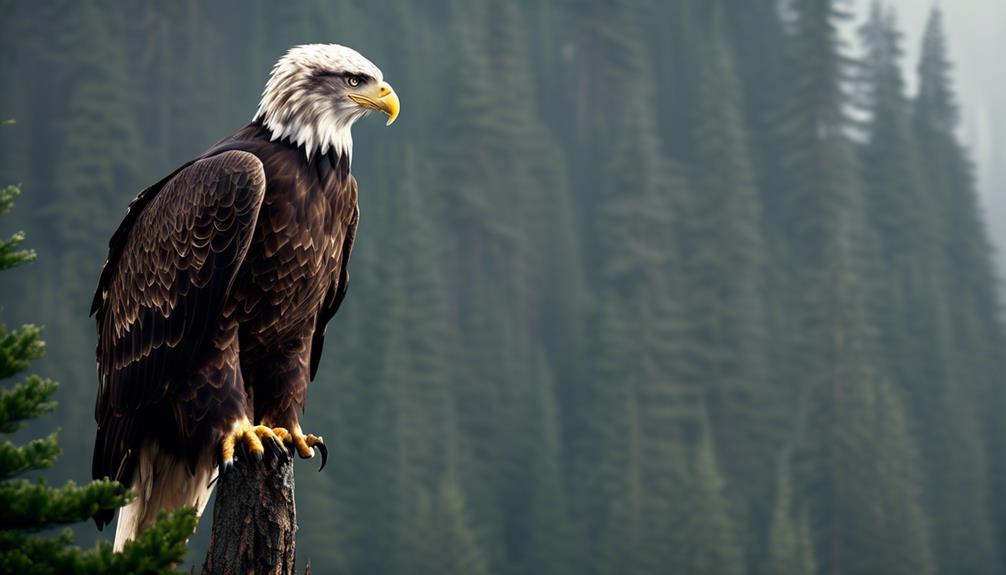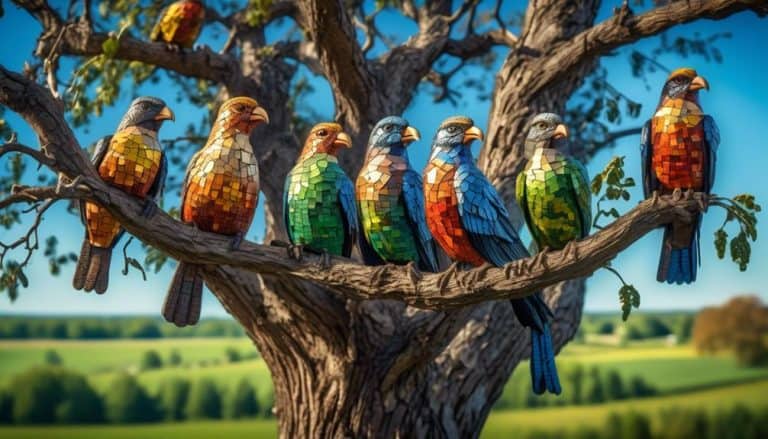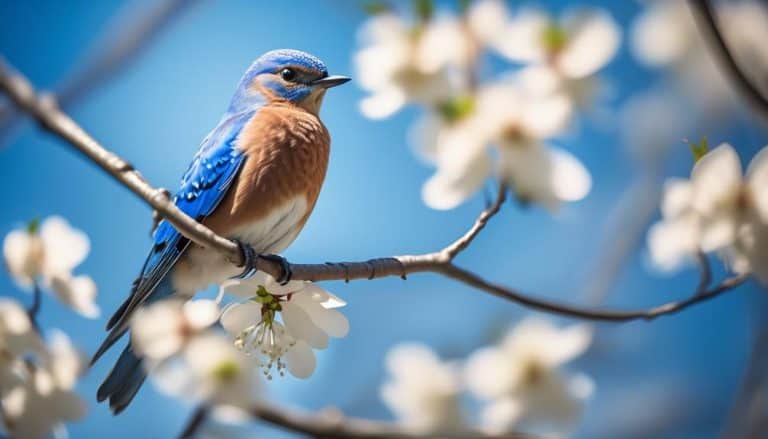As I sit here in my office, surrounded by stacks of research papers and field notes, I can't help but marvel at the remarkable creatures that call Washington State home.
Birds of prey, with their majestic wingspans and piercing gazes, have always captured my imagination. From the Bald Eagle, a symbol of strength and resilience, to the Peregrine Falcon, a master of speed in the skies, these magnificent creatures have intrigued scientists and nature enthusiasts alike.
But there is so much more to discover about these remarkable predators, and the secrets they hold within the vast landscapes of Washington State are waiting to be unearthed.
The Bald Eagle: Symbol of Strength
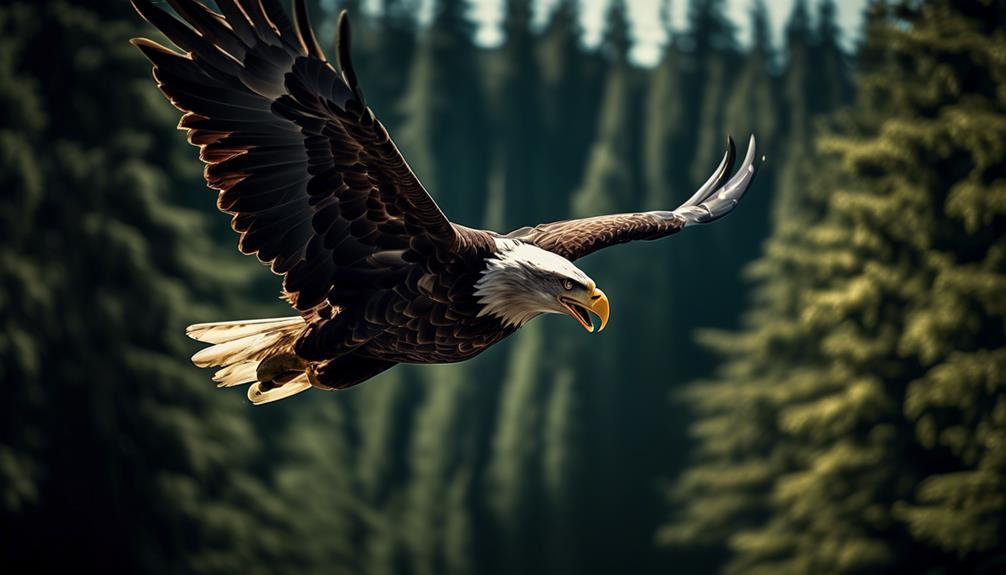
The Bald Eagle, a majestic bird known for its impressive physical strength and commanding presence, holds a significant role as a symbol of power and resilience in Washington State. This iconic bird serves as a symbolic representation of the nation's ideals and values. Recognized as the national emblem of the United States, the Bald Eagle embodies strength, freedom, and courage.
With its striking white head and tail contrasting against its dark brown body, the Bald Eagle is instantly recognizable. It possesses a wingspan of up to seven feet, making it one of the largest birds of prey in North America. Its powerful beak and sharp talons enable it to catch and carry prey, showcasing its remarkable physical prowess.
In Washington State, the Bald Eagle can often be spotted near bodies of water, such as rivers and lakes, where it feeds on fish. It's also known to scavenge for carrion, displaying its adaptability and resourcefulness. The presence of the Bald Eagle in the state serves as a reminder of the diverse and rich natural heritage that Washington holds.
Furthermore, the symbolic significance of the Bald Eagle extends beyond its physical attributes. As a national emblem, it represents the ideals of freedom, resilience, and power. Its regal appearance and soaring flight inspire a sense of awe and admiration. The Bald Eagle's presence in Washington State serves as a constant reminder of the strength and tenacity of the American spirit.
The Peregrine Falcon: Speed in the Skies
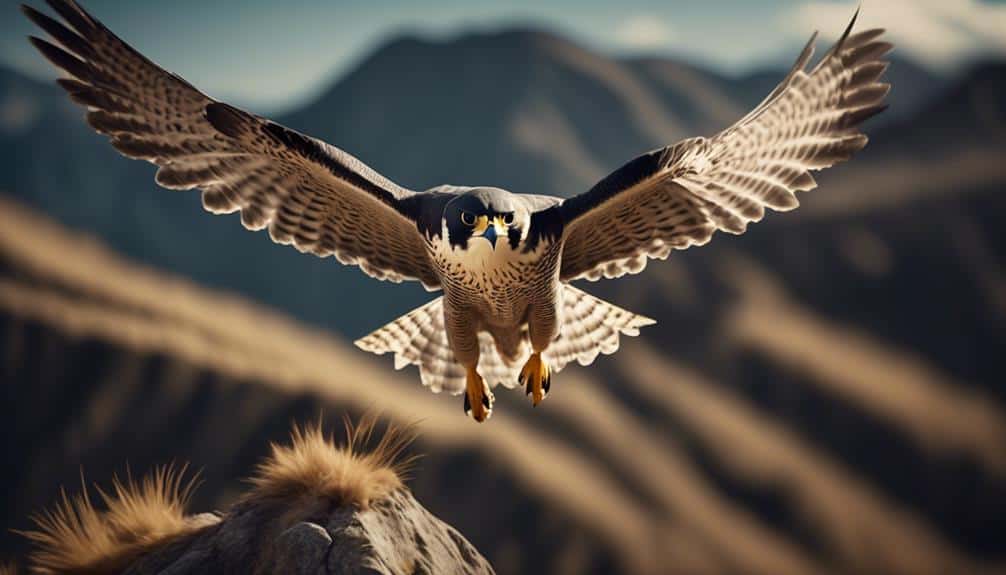
After exploring the significance of the Bald Eagle as a symbol of strength and resilience, we now turn our attention to the Peregrine Falcon, a bird renowned for its incredible speed and agility in the skies.
The Peregrine Falcon, scientifically known as Falco peregrinus, is a formidable predator that employs advanced hunting techniques to capture its prey. Here are some key aspects of the Peregrine Falcon's hunting prowess:
- High-speed stoop: The Peregrine Falcon is famous for its hunting technique called the 'stoop.' It soars high into the sky, then abruptly folds its wings and dives at astonishing speeds towards its prey. During this stoop, it can reach speeds of over 240 miles per hour, making it the fastest animal in the world.
- Strategic strikes: Once the Peregrine Falcon has locked onto its target, it uses its sharp talons to strike with deadly precision. Its feet possess a strong grip, allowing it to capture birds, bats, and even small mammals in mid-air.
- Migration patterns: Like many birds, the Peregrine Falcon undertakes long-distance migrations. These migrations can span thousands of miles, with some individuals traveling from their breeding grounds in the Arctic to their wintering grounds in South America. This remarkable journey showcases the Peregrine Falcon's endurance and navigational abilities.
The Red-tailed Hawk: Master of Adaptation
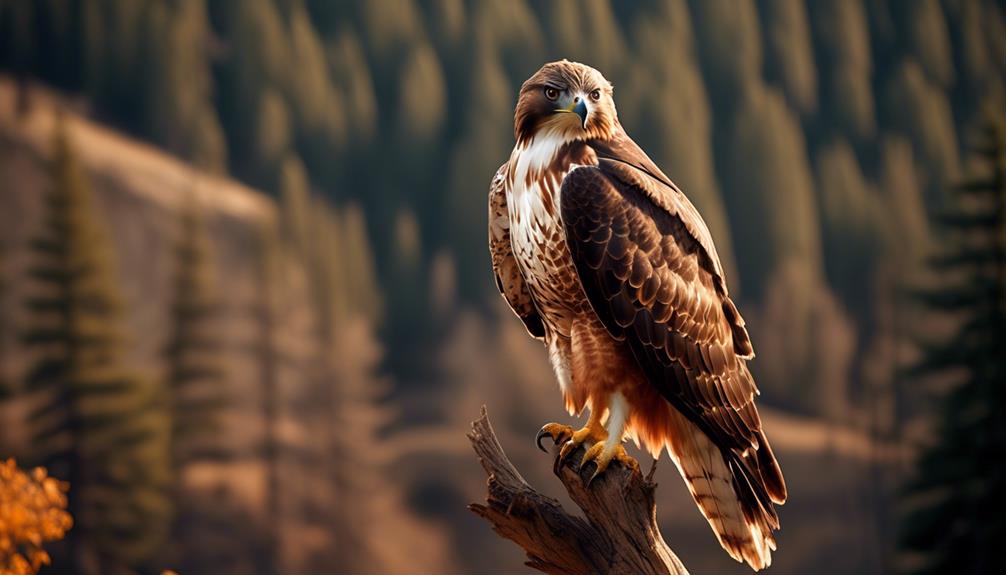
With its remarkable ability to adapt to various environments, the Red-tailed Hawk has established itself as a true master of survival. This bird exhibits a range of adaptive behaviors and hunting techniques that enable it to thrive in diverse habitats across Washington State.
One of the key adaptive behaviors of the Red-tailed Hawk is its ability to adjust its diet according to the available prey. This raptor is known for its opportunistic feeding habits, which allow it to switch between small mammals, birds, reptiles, and even carrion. By being flexible in its food choices, the Red-tailed Hawk ensures a constant supply of nourishment, regardless of the specific ecosystem it inhabits.
In terms of hunting techniques, the Red-tailed Hawk displays exceptional versatility. It primarily relies on its keen eyesight to spot potential prey from great distances. Once a target is identified, it employs a combination of soaring and perching to survey the area and plan its attack. The Red-tailed Hawk is an adept aerial hunter, using its sharp talons and powerful beak to capture and kill its quarry.
In addition to its hunting prowess, the Red-tailed Hawk also demonstrates adaptability in its nesting habits. While this species typically constructs nests in tall trees, it has been observed using man-made structures such as electrical poles and buildings in urban environments. This ability to adapt its nesting behavior allows the Red-tailed Hawk to successfully breed and raise its young in various landscapes.
The Great Horned Owl: Silent Hunter of the Night
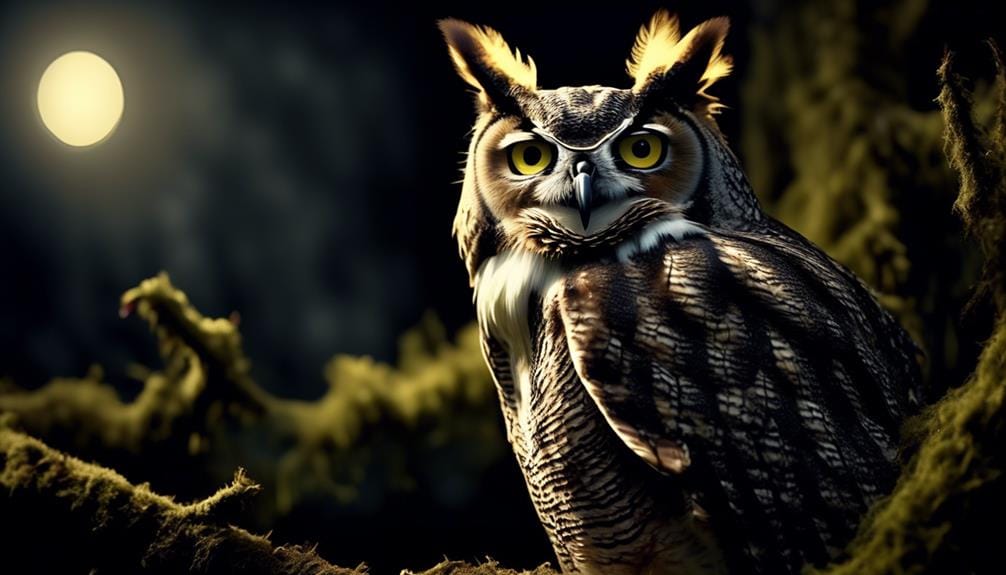
During the nocturnal hours, the Great Horned Owl employs its remarkable stealth and acute hearing to silently hunt its prey. This majestic bird of prey, known for its distinctive ear tufts and piercing yellow eyes, possesses nocturnal habits that make it a formidable hunter in the dark. Let's explore the unique hunting techniques of the Great Horned Owl:
- Feather adaptations: The Great Horned Owl's flight feathers have special serrations that reduce noise during flight, allowing it to approach its prey silently. These adaptations enable the owl to surprise its victims without any warning.
- Silent flight: The Great Horned Owl possesses large wings that generate minimal noise while flying. This stealthy flight, combined with its specialized feathers, allows the owl to glide through the night sky undetected by its prey.
- Acute hearing: One of the key factors that make the Great Horned Owl such an effective hunter is its exceptional hearing. The owl has large, asymmetrical ear openings, which enhance its ability to locate prey accurately. Its ears are positioned at different heights on its head, enabling it to pinpoint the exact location of its prey based on sound alone.
The Great Horned Owl's nocturnal habits and unique hunting techniques make it a master of the night, silently stalking and capturing its prey with precision and efficiency.
The Osprey: Fishing With Precision
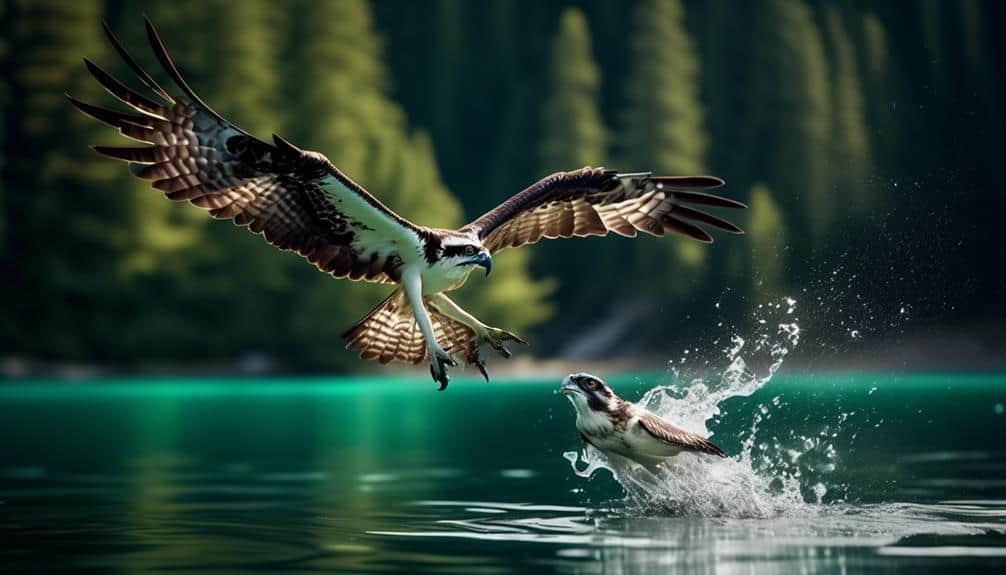
The Great Horned Owl's specialized hunting techniques in the dark aren't the only impressive skills among the birds of prey in Washington State. The Osprey, also known as the fish hawk, possesses remarkable fishing techniques and unique nesting habits.
The Osprey is a master at catching fish, using its keen eyesight to locate its prey from high above. Once a fish is spotted, the Osprey hovers over the water, calculating the perfect moment to strike. With remarkable precision, it dives into the water, talons outstretched, and snatches the fish with its sharp claws. Its reversible outer toes and spiky foot pads help secure the slippery catch.
Nesting is another fascinating aspect of the Osprey's behavior. Unlike most birds, the Osprey builds its nest primarily with sticks and twigs, often on man-made structures such as utility poles or nesting platforms. These nests can be massive, reaching up to six feet in diameter. The male and female Osprey work together to construct and maintain the nest, with the female taking the lead in arranging the materials.
The Cooper's Hawk: Stealthy Predator
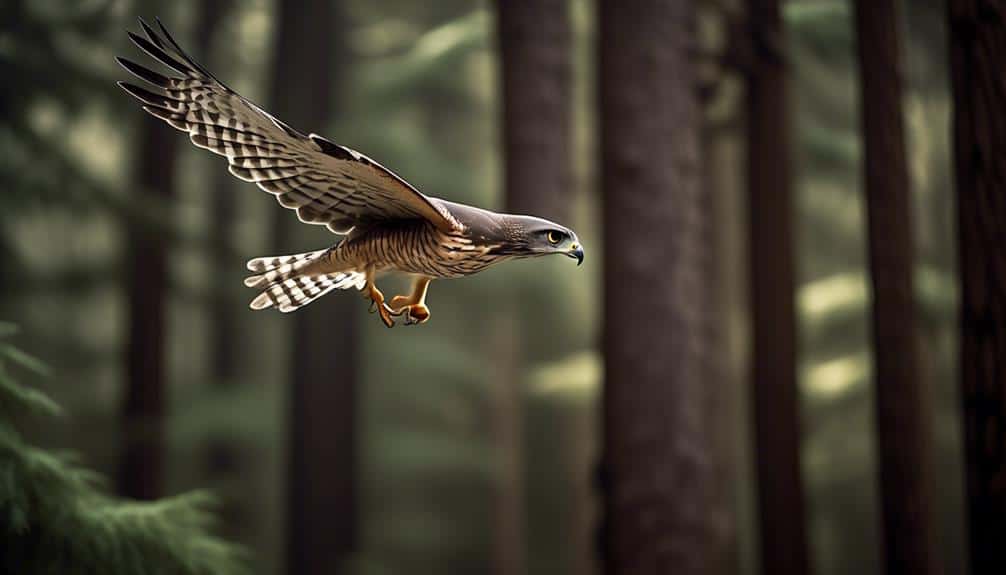
Cooper's Hawks, known for their stealthy hunting prowess, are formidable predators within the avian community in Washington State. These sleek raptors employ a variety of hunting techniques to capture their prey with precision.
- Ambush: Cooper's Hawks are experts at surprising their victims. They patiently perch in dense vegetation, waiting for an unsuspecting bird to come within striking range. With lightning-fast reflexes, they launch themselves towards their prey, using their sharp talons to secure a successful kill.
- Pursuit: When a Cooper's Hawk spots a potential target in the open, it unleashes its incredible speed and agility. With rapid wing beats and sharp turns, it chases its prey through the air, using its exceptional maneuverability to outmaneuver and seize its quarry.
- Cooperative hunting: These hawks have been observed engaging in cooperative hunting strategies. They form hunting parties, where multiple individuals work together to encircle and drive their prey towards a designated falconer. This collaborative effort increases their chances of capturing elusive prey.
When it comes to nesting habits, Cooper's Hawks prefer to build their nests in the dense foliage of tall trees. They construct their nests using sticks, twigs, and other plant materials, creating a sturdy platform for their eggs. These hawks are monogamous and typically return to the same nest site year after year, reinforcing the structure as needed.
Frequently Asked Questions
How Many Different Species of Birds of Prey Can Be Found in Washington State?
In Washington State, there are various species of birds of prey. Their numbers fluctuate due to bird migration patterns. Conservation efforts are important to ensure the protection and preservation of these magnificent creatures.
What Is the Average Lifespan of a Bald Eagle?
The average lifespan of a bald eagle is around 20 years. These majestic birds have fascinating nesting habits, constructing large nests high up in trees.
How Do Peregrine Falcons Catch Their Prey While Diving at High Speeds?
Peregrine falcons have remarkable hunting techniques. With their high-speed dives, they can reach speeds up to 240 miles per hour. This incredible velocity allows them to surprise and capture their prey with incredible force and accuracy.
What Are the Main Factors That Contribute to the Adaptation Skills of Red-Tailed Hawks?
The main factors that contribute to the adaptation skills of red-tailed hawks are their keen eyesight, powerful talons, and ability to soar for long periods. These attributes enable them to effectively hunt and survive in their environment.
How Do Ospreys Locate Their Prey in the Water Before Diving Down to Catch It?
Ospreys use a combination of visual and auditory cues to locate their prey in the water before diving down to catch it. Their hunting techniques involve keen eyesight, the ability to hover, and acute hearing for detecting fish movements.
Conclusion
In conclusion, the birds of prey in Washington state showcase remarkable strength, speed, and adaptability.
From the majestic Bald Eagle soaring high in the sky to the swift Peregrine Falcon diving at incredible speeds, these creatures embody the power and beauty of nature.
The Red-tailed Hawk's ability to adapt to various environments and the Great Horned Owl's silent hunting skills further emphasize their remarkable abilities.
With precision and grace, the Osprey and Cooper's Hawk demonstrate their prowess as skilled predators.
Washington state truly is a haven for these magnificent birds of prey.

